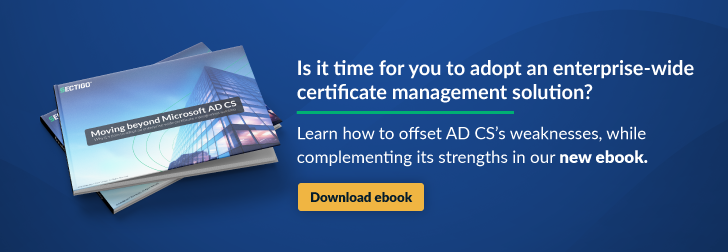Streamlining certificate management: The case for eliminating Microsoft Active Directory Certificate Services
Manual certificate tracking with Microsoft Active Directory Certificate Services (AD CS) creates inefficiencies and compliance risks. Eliminating manual processes with automation enhances security, streamlines renewals, and ensures compliance. Move beyond Microsoft AD CS for streamlined processes with Sectigo Certificate Manager.
Table of Contents
Efficient certificate management is paramount for ensuring the security, compliance, and productivity of an organization. Unfortunately, relying solely on Microsoft Active Directory Certificate Services (AD CS) often translates to a laborious manual tracking process, leading to productivity pitfalls and compliance challenges. There are drawbacks in manual tracking, and there is a strong case to adopt purpose-built certificate lifecycle automation.
Eliminating manual tracking burdens: The AD CS dilemma
Microsoft AD CS, while offering a solution for managing PKI certificates, falls short in providing the user-friendly dashboard, notifications, and consolidated reporting you need to run your business efficiently. One of the biggest concerns with utilizing MS AD CS is the inability to address non-MS applications. This lack of interoperability increases the reliance on tracking these devices manually, adding to their workload and overall inefficiencies. This deficiency places a heavy burden on administrators who are left grappling with fragmented spreadsheets and tribal knowledge to manually track everything related to certificates.
A tedious journey due to partial visibility
Without the luxury of lifecycle automation, administrators find themselves caught in a constant cycle of manually tracking certificates. This process, though seemingly straightforward, introduces several challenges:
- No central data source: Information is scattered across a mix of documents, spreadsheets and emails, making it challenging to piece together a comprehensive view of the certificate landscape.
- Information gaps: As certificates undergo issuance, renewal, and revocation, information gaps inevitably emerge, leading to potential oversights and missed deadlines.
- Missed renewals: The lack of a centralized tracking mechanism increases the likelihood of missing important dates and renewals, resulting in the unnecessary risk of service outages.
- Version control failures: The turnover of administrators can lead to version control failures, erasing institutional knowledge and creating potential security risks.
Chaotic renewal process: scaling challenges
Renewing certificates in a spreadsheet-based environment becomes a chaotic and time-consuming process:
- Individual identification: Each certificate must be individually identified for renewal, leading to a slow and error-prone process.
- Validation complexity: Different certificate types require distinct validation steps, adding complexity to the renewal process.
- Disparate approval methods: Approvals are managed through various channels, such as email, chat, or ticketing workflows, creating a lack of cohesion in the renewal process.
- Separate procurement and billing: Managing procurement and billing separately further adds to the administrative workload and potential billing discrepancies.
Weak compliance posture: the auditor's dilemma
Auditors demand robust evidence and centralized reports for compliance verification. Manual tracking falls short in meeting modern compliance standards:
- Tedious certificate lookups: Manual records make certificate lookups a tedious process, hindering rapid responses during audits.
- Scattered histories: Certificate histories are scattered across multiple documents, making it challenging to present a comprehensive compliance posture.
- Demonstrating compliance difficulty: Comprehensive compliance is nearly impossible to demonstrate without consolidated and easily accessible records.
Solving the tracking problem: Sectigo Certificate Manager
The solution to these manual tracking burdens lies in purpose-built certificate lifecycle automation, exemplified by Sectigo Certificate Manager. This innovative solution offers:
- Full visibility: A centralized dashboard providing insights into the full certificate inventory, streamlining visibility and tracking.
- Policy-based workflows: Automated, policy-based workflows for issuing and renewing certificates at scale, reducing the manual workload on administrators.
- Proactive alerts: Alerts that proactively notify administrators of impending expirations, preventing surprises and potential service outages.
- Consolidated audit trails: Comprehensive and consolidated audit trails for instant compliance reporting, meeting the stringent requirements of auditors.
By adopting Sectigo Certificate Manager, organizations can eliminate manual burdens, restore productivity, and reduce business risks associated with inefficient certificate management. The unified approach to tracking and automation not only simplifies administrative tasks but also strengthens an organization's security posture and compliance adherence in today's dynamic and complex cybersecurity landscape.
Want to learn more? Get in touch to book a demo of Sectigo Certificate Manager!
Related posts:
How Certificate Lifecycle Management helps address the IT skills gap

